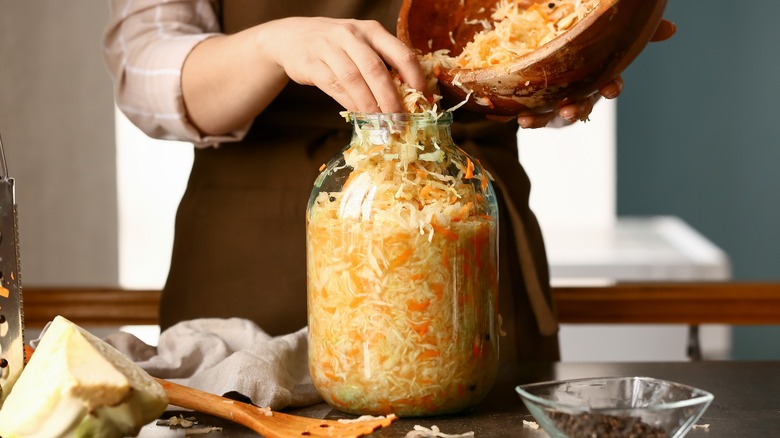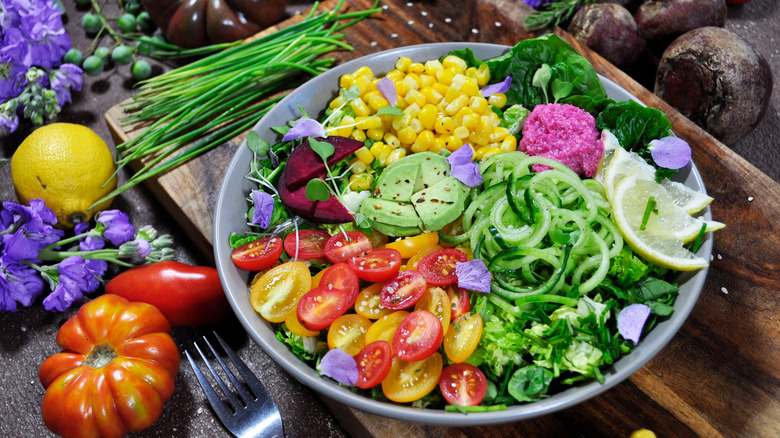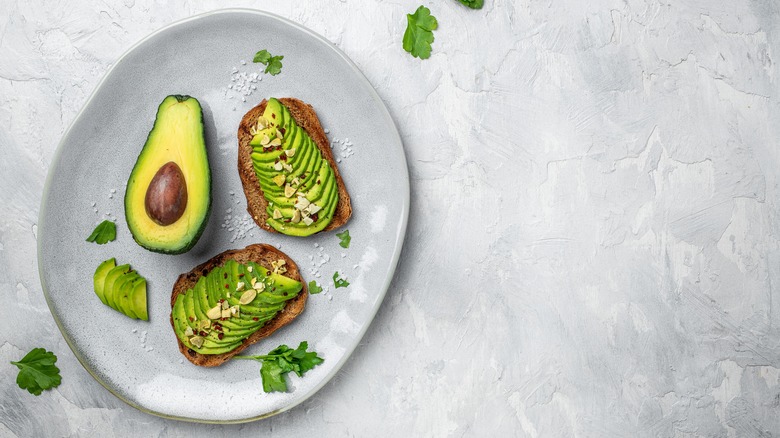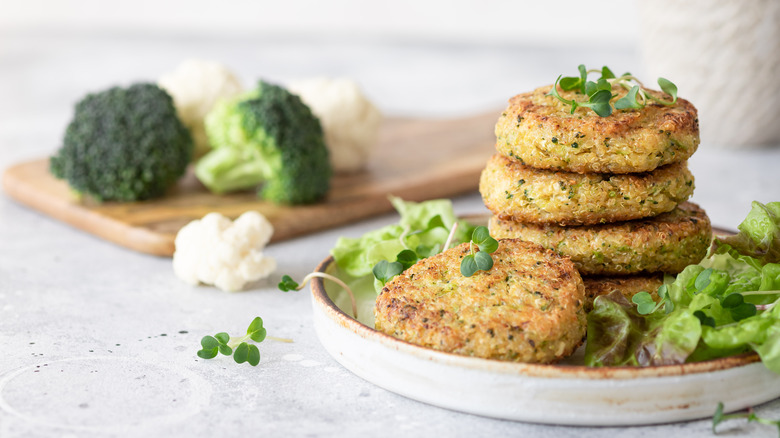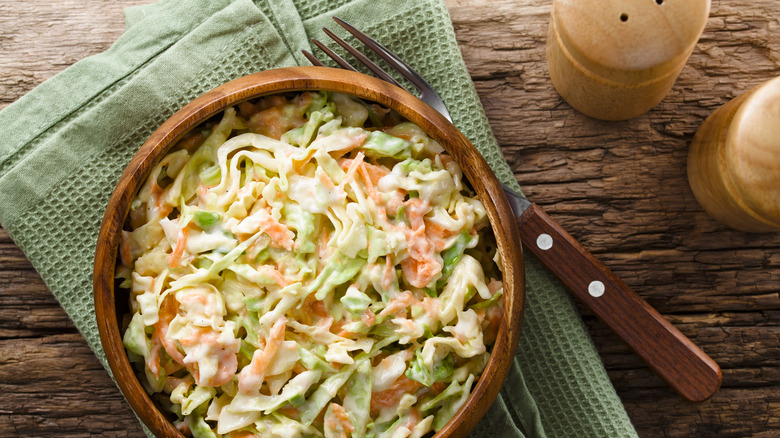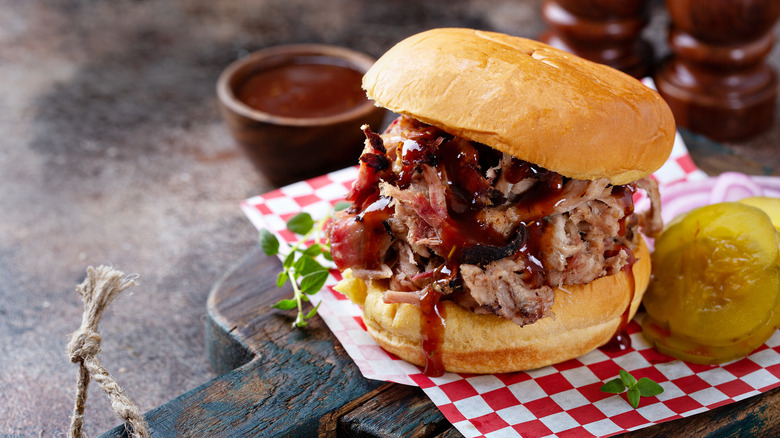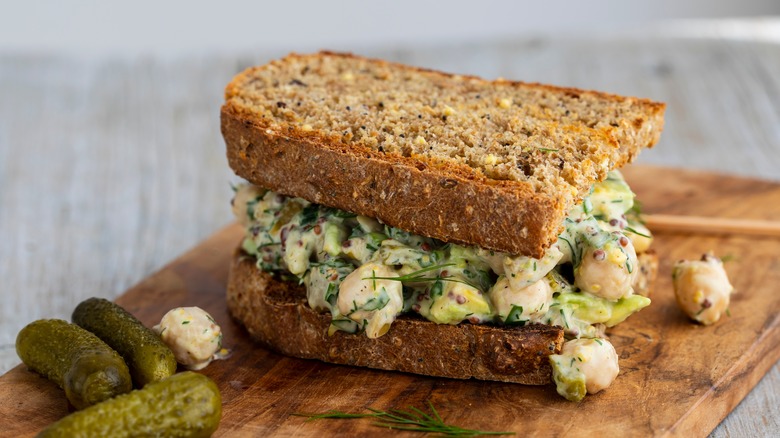12 Ways To Use Sauerkraut In Your Favorite Dishes
Fermented veggies are one of those types of food that people either can't stand or can't get enough of. They are fizzy, tangy, pungent, and loaded with flavor. Sauerkraut is simply fermented cabbage, and it can be described as salty, sour, and tangy. In fact, you should start eating more sauerkraut because of the incredible health benefits. But including a new food in your cooking may not be as easy as it sounds. Luckily, it's incredibly versatile when it comes to culinary application, and we've listed the top ways to use sauerkraut in your favorite dishes.
Yes, you can certainly eat a big fork full of sauerkraut plain, enjoy a big pile as a side dish, or load it up on your hot dog or bratwurst. However, there are plenty of think-outside-the-box ways to include this chewy, tangy fermented food into your everyday cooking, and help to elevate your already-delicious recipes. Enjoy both the flavor and health benefits of eating a little sauerkraut every day. We're certain once you board the sauerkraut train, you won't be getting off anytime soon.
Stir into soup
When making homemade soup, it's easy to end up with a flavorful creation where there's just something missing that you can't put your finger on. Most of the time, it's a flavor that falls into one of four categories: salty, sweet, acidic, and fatty. Because there are plenty of sweet veggies out there, salty broths, and fatty oils, it's likely that you're missing your acidic component. The acid flavoring can be anything from citrus and vinegar to something alkaline like fermented foods which have a similar tanginess to them. If you're making a broth-based soup, consider including sauerkraut to help create a balanced mouthfeel.
In addition, an ingredient like sauerkraut can add a pleasing texture and give a thin soup some extra substance. It works particularly well in a Russian borscht soup, chicken noodle soup, dill pickle soup, or old-fashioned beef stew recipe. Any brothy soup that calls for cabbage, or pickled ingredients tends to work well. Sauerkraut can be cooked right into the pot, or added on top after it's been plated.
If you're looking to incorporate those tangy and salty notes into the entire recipe, use some of your sauerkraut juice as part of the broth. Even just a few tablespoons can make a difference, and add a pleasing fermented burst of flavor to the overall flavor.
Over salad
There's a reason people tend not to crave salad. Most salads are made with few basic ingredients and are not given the time and consideration they deserve. In order to make a crave-worthy salad, it's all about preparation, using unique ingredients, loading on the toppings, and of course, mixing in a delicious dressing. Iceberg lettuce, pre-shredded carrots, and whole grape tomatoes with bottled ranch just doesn't cut it. Instead, put a little heart into the creation with a base of flavorful greens like arugula, massaged kale, shredded Brussels sprouts, or grilled romaine.
Make your own vinaigrette or creamy herbed dressing. And finally, include flavorful ingredients that complement one another. Sauerkraut is the perfect topping for any salad with a base of dark leafy greens. Use just enough sauerkraut so that you get a few shreds in every bite without overwhelming the natural and subtle flavors of the other vegetables. Include it in salads with bold flavors like kale and roasted beet salad with feta. Add a handful to your taco salad to give it an acidic flavored kick, or use it in a loaded vegan gardener's salad with roasted vegetables, sprouts, avocado, grilled broccoli, and corn.
Use a vinegar-based dressing, or one including mustard, and include plenty of fresh herbs to add refreshing peppery sweetness to the composition. You can even include some sauerkraut juice in your homemade dressing as a salty addition. The texture of the 'kraut will add a crunch to create a varied mouthfeel.
As a taco topping
Taco Tuesday doesn't have to be predictable. Jazz up those little corn boats of texture and flavor with pickled and fermented vegetables. You may have already discovered the wonders of pickled red onion on tacos, but you don't have to stop there. Try using fresh sauerkraut as a tangy taco topper on both spicy traditional meat and lentil walnut or bean vegan tacos.
If you're all about the sauce, consider mixing sauerkraut right into your flavored spicy aioli, along with diced sweet onion and fresh cilantro. If you're used to including quite a bit of lime juice to flavor your beans, leafy greens, or aioli, try adding a little sauerkraut juice instead, or in addition. Shredded cabbage or slaw are both common toppings for tacos and fermented and pickled vegetables make a tangy and punchy addition, so why not kill two birds with one stone? Elevate those street tacos by including this unexpected ingredient, which can turn Taco Tuesday into a day filled with culinary creativity and flavor.
Enjoy in an omelet
Are you in the routine of making the same breakfast eggs every morning? Well, at this point you know what you like whether that means sunny side up, over easy, scrambled, or even vegan JUST eggs. If you're a fan of adding hot sauce, Italian dressing, or ketchup to your eggs, then you certainly like that vinegar undertone paired with America's favorite breakfast food, and would likely enjoy a nice pile of sauerkraut alongside your eggs. The probiotic food is a fantastic morning addition because it helps balance your gut and aid in digestion, per Nutrients. What a great way to start your day.
An elite way to incorporate sauerkraut into eggs is by stuffing it right into a simple omelet recipe or mixing it into a frittata. Pair with vegetables like mushrooms, onions, leeks, and potatoes, and when it comes to cheese, the world is your oyster. You can also enjoy a pile of warm sauerkraut right on top or next to your egg creation. Consider including a layer of sauerkraut in your eggy breakfast sandwich. Whichever way you decide to pair eggs with sauerkraut, you'll be impressed by the intense contrast of texture and flavor between the silky fatty eggs and crunchy refreshing 'kraut.
Use in a stirfry
As we all know, stir fry can sometimes contain everything-but-the-kitchen-sink vibes, but it really is best to plot out a theme and stick to it when it comes to ingredients. Stick to five or fewer ingredients, and try to use a variety of both texture and flavor. Luckily, an ingredient that seems to go with most vegetables and quite a few meats is sauerkraut. It certainly varies from your average bite-sized, chopped veggie, and is loaded to the brim when it comes to flavor. It's an ingredient that is shredded small enough so you can get a little with each bite but doesn't overwhelm the palate if added in reasonable amounts.
Use a forkful of sauerkraut in your vegetable stir fry. Sauerkraut tends to complement almost any kind of sausage, chopped steak, and gamier meats, along with seafood. Whip together a standard stir-fry sauce recipe, or simply use garlic, ginger, tamari, mustard, or other flavor boosters to give your dinner some additional flavor. Opt not to use sauerkraut if you have other intensely tangy fruits or vegetables like pineapple as statement pieces in your recipe, and instead, let it be a shining ingredient on its own.
Top avocado toast
The secret to saving money on avocado toast is to simply make it at home. Mind blown, right? This also gives you ultimate control over what exactly is topping that avocado with flavor, how well the avocado is mashed, and the type of bread you'd like to use. All of these decisions are incredibly important, and while many toppings like eggs, everything seasoning, and truffle oil are extremely popular, you should consider adding sauerkraut to your homemade avocado toast.
If you decide to use this tangy addition, it's completely up to the artist how much sauerkraut can get loaded onto the toast. If you plan on using quite a heap, then it's important to balance it with plenty of avocados and use a structurally sound piece of toast. In fact, the best type of bread for avocado toast is sourdough, which when toasted can hold quite a bit of weight. It's especially a good pick for sauerkraut avocado toast because both ingredients have that undertone of sourness to them, that mimic and complement each other. Use room temperature, or slightly heated sauerkraut, and feel free to omit any additional salt from the equation, as the fermented cabbage itself is quite salty already.
Incorporate into veggie patties
Longtime vegetarians know that the secret to a great homemade veggie burger is to think outside of the box, zero in on boosting flavor, and be selective when choosing a binder. There are some great vegan burgers out there that can certainly mimic the flavor of meat, but when it comes to veggie burgers made with real vegetables, it's best to lean into those wonderful natural vegetable flavors. A great way to add intensity of flavor is to include fermented vegetables, like sauerkraut.
If you prefer a more ground-up texture, then consider chopping your sauerkraut before incorporating it into your other ingredients. Depending on the brand, sauerkraut can be soft, or very chewy and stringy, so you may want to take a knife to it. Sometimes a food processor can get the job done, but it tends to be a bit rubbery for the blades.
Use sauerkraut to add flavor and texture to hearty black bean burgers, sweet potato burgers, quinoa burgers, and chickpea burgers. Then, when they are all cooked up and ready to serve, don't forget to include warm sauerkraut as a topping, especially if you plan on using mustard or a Russian dressing-type creamy tomato sauce.
Elevate your coleslaw
Ever notice that coleslaw tastes even better the second day after it's had a chance to sit? This is because the cabbage was able to soften and soak in the flavors and juices overnight. Because most coleslaw dressings include vinegar, whether they are a creamy base or not, the cabbage tends to pickle just slightly and soften. In order to give your coleslaw that tangy flavor without having to wait until the next day, consider mixing a little sauerkraut into your cabbage and other shredded ingredients. This is the ultimate shortcut to achieve some variety in textures as well as to enhance the overall flavor.
Make your own homemade coleslaw dressing using mayonnaise or vegan mayo, vinegar, a sweetener, and pepper. Consider including celery seed, mustard, and a splash of sauerkraut juice for extra flavor. Because sauerkraut is made from shredded cabbage, the main ingredient in coleslaw, you really can't go wrong by adding a few forkfuls.
Layer into a pulled pork sandwich
Sauerkraut makes a great addition to coleslaw but can also be used in place of the crunchy cabbage side. If you're used to loading up your hot dogs, fried chicken sandwiches, or pulled pork with creamy cabbage slaw, then you should consider using sauerkraut instead. The sweet creamy, and incredibly crunchy coleslaw can be replaced by a fermented, tangy, chewy version of the same vegetable. It's more powerful in flavor but tends to be less spicy. When paired with barbecue sauce, it mimics some of the acidic flavors and intensity, creating a mouthfeel that can't go ignored.
When making an easy pulled pork recipe or a vegan jackfruit bbq sandwich, consider using a heaping pile of sauerkraut to top it off. If you're used to adding coleslaw to your pulled pork sandwiches, then you might enjoy adding your 'kraut cold, but otherwise, it's a good idea to heat it up enough so it's at least room temperature. Since sauerkraut and coleslaw taste so good together, you may also opt to use a combination.
The saltiness of the sauerkraut helps to balance the sweetness of the barbecue sauce. It also helps to enhance any subtle spiciness the barbecue sauce may carry. If you can, find a crunchier, thicker cut sauerkraut, which will add more texture and be less likely to melt into the pulled pork. You can often find this more substantial sauerkraut in the refrigerator section or locally fermented.
Mix into tuna or chickpea salad
Your go-to recipe for tuna or chickpea salad makes be loaded with ingredients like celery, red onion, chopped dill pickles, capers, or even olives. Those little power-packed chopped-up bits of flavor and crunch add quite a bit to the overall composition of the recipe. Pickles, in particular, add a nice acidic, pickled element that can be quite pleasing. If you enjoy that particular flavor in your tuna or chickpea salad recipe, then consider opting for a fermented vegetable, like sauerkraut.
Sauerkraut can make a nice addition, especially to a vegan chickpea salad sandwich because the tendril-like shreds of fermented cabbage can help to hold those mashed beans into place. The tangy flavors of the sauerkraut mirror those of the lemon juice, apple cider vinegar, or whatever type of acid you decide to use in your dressing. It pairs well with classic ingredients for both chickpea and tuna salad and just happens to taste delicious with fresh dill, tarragon, and garlic.
Start by mixing in only a fork full of 'kraut and consider including a little bit of its fermented juices as well. This addition can take your simple yet refined tuna sandwich to the next level with just a forkful, so be sure not to overdo it. Sauerkraut works particularly well in a mustard-heavy recipe, although you'll want to be sure to limit any additional salt going into the sauce.
Press into your grilled cheese
America's most simple yet truly beloved sandwich is easy to make, hard to mess up, and always welcoming flavor-boosting ingredients. Love a spin on the classic? Perhaps you are intrigued by a brie and fig grilled cheese, or apple and cheddar. Maybe tomato slices with American cheese, or a little buffalo sauce and blue cheese is more your style. Or maybe it's all about cheese layering and you love to make grilled cheese sandwiches with cheddar and gruyere. Whichever way you like to enhance the basic recipe, you should consider adding sauerkraut as a savory and flavorful addition.
Especially if you're a fan of the classic Reuben, this culinary adaptation was made for you. Sauerkraut pairs well with most cheese but tastes especially delicious with Swiss, cheddar, American, and provolone. Choose a flavorful bread, like rye or sourdough to help balance the intensity of the fermented cabbage. A small smattering of dijon or honey mustard can also help bring balance to the sandwich and is a condiment often used with sauerkraut.
If you are already a fan of sauerkraut then pile it on heavy, but for those just dipping their toes in the water, use just a forkful and let the cheese be the superstar ingredient. Try your best to press out any excess moisture before adding it to your sandwich, as you want to avoid making your bread mushy instead of crispy. Enjoy the simplicity of a decked-up grilled cheese with a twist.
Serve over a baked potato
We love a good loaded baked potato and know that when it comes to toppings the options are endless. Typically we find that starting with a solid base is extremely important, so follow some tips you need for delicious baked potatoes, every time. Once your potato is fluffy, cooked through, and ready to devour, consider piling it high with sauerkraut. The loaded flavors of the 'kraut will pair nicely with the mild and buttery baked potato. Consider using sauerkraut in combination with sour cream, chopped sweet onion or caramelized onions, gruyere, or Swiss cheese, and bits of bacon or other cured meats.
For this topping, you'll want to be sure that you've warmed up the sauerkraut and drained it. There's nothing worse than a cold or watery baked potato. You can also dip your uncooked potato into the sauerkraut juice before baking it, to give it a salty brine that will help to flavor and crisp the skin. This works especially well when using the classic russet potato as a base, as its skin is slightly tougher than a Yukon gold or red potato. This side dish goes fantastically with classically German cuisine, but can also be a fun spin on a steak-and-potatoes everyday meal.
